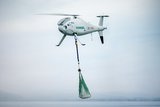Northrop Grumman's Hunter Reaches 75,000 Flight Hours Operational Milestone
Northrop Grumman Corporation's Hunter Unmanned Aircraft System (UAS), in use with the US Army since 1996, recently surpassed 75,000 flight hours in service, 50,000 of which were flown in combat.
The MQ-5B Hunter, which is currently deployed in the Global War on Terrorism, provides warfighters with state-of-the-art reconnaissance, surveillance, target acquisition (RSTA), communications relay, and weapons delivery.
"Not only is Hunter a workhorse for the Army, but it's also a proven combat multiplier that continues to provide our warfighters with actionable intelligence," said Dave Werkheiser, vice president and general manager of the Life Cycle Optimization and Engineering Group for Northrop Grumman's Technical Services sector. "What makes the Hunter program so special is that we serve shoulder-to-shoulder with the great men and women in the Army keeping Hunter mission capable. Also, Hunter has proven to be an extremely adaptable and a highly reliable platform that has been spirally enhanced for both performance and payload capability."
The RQ-5A Hunter was the Army's first fielded UAS. The MQ-5B is the next-generation Hunter, continuing a legacy of service to Army corps, division and brigade warfighters. Flying over the battlefield with its multi-mission optronic payload, the MQ-5B gathers RSTA information in real time and relays it via video link to commanders and soldiers on the ground.
The MQ-5B Hunter is distinguished by its heavy fuel engines (a US Department of Defense first), its "wet" (fuel-carrying) extended center wing with weapons-capable hard points and a modern avionics suite. The MQ-5B Hunter system uses the Army's One System ground control station and remote video terminal. It also carries a communications relay package to extend the radio range of warfighters. A differential GPS automatic takeoff and landing system is under development for Hunter.
"The benefit of Hunter to our warfighters is obvious," said Karl Purdy, Northrop Grumman Technical Services' program manager. "Our service men and women serving in theater can rest a bit more comfortably with Hunter in the field as it has continuous 'eyes' over the battle space. Hunter has recently been projected as an important part of the Army's UAS capability until 2025. This flight performance milestone would not be possible if not for the hard work of a team that continues to operate and maintain this system with unparalleled expertise."
The MQ-5B features a robust, fixed-wing, twin tail-boom design with redundant control systems powered by two heavy fuel engines -- one engine to "push" and another to "pull" the air vehicle. Another Hunter capability is its relay mode that allows one Hunter to be controlled by another UAV at extended ranges or over terrain obstacles typical of those found in the Balkans and Afghanistan.
To replace obsolete systems, increase readiness and reduce the logistics burden on soldiers, Northrop Grumman integrated a new suite of avionics for Hunter, including upgraded flight and mission computers, an auxiliary power distribution unit, the LN-251 inertial navigation system with GPS, a downsized data link system, and an APX-118 IFF transponder. The avionics suite improves performance by reducing size, weight, and power consumption of the equipment used to control the aircraft and manage its critical subsystems.
More from Uncrewed Vehicles
-
Jammer resistant drone designs spark search for countermeasures
The Russia-Ukraine conflict has driven another stage of evolution for drones and the counter measures to defend against them.
-
![L3Harris launches Amorphous software for control of uncrewed platforms]()
L3Harris launches Amorphous software for control of uncrewed platforms
The new Amorphous software is a universal controller that would allow a single operator to control a swarm of “thousands” of uncrewed systems, from drones to underwater platforms.
-
ideaForge unveils new UAVs at Aero India 2025
India UAV supplier ideaForge has launched the Netra 5 and Switch V2 drones at Aero India 2025, boasting of enhanced endurance, AI-driven autonomy and improved operational capabilities.
-
![Shaping the future of defence: What 2025 holds for the global drone market]()
Shaping the future of defence: What 2025 holds for the global drone market
The UAV market is experiencing unprecedented growth, with innovations in technology and battlefield applications driving demand across military sectors. From the battlefields of Ukraine to NATO exercises and beyond, drones are transforming how wars are fought and supported.
-
![Maris-Tech confirms customers signing up for Jupiter Drones codec and AI-powered system]()
Maris-Tech confirms customers signing up for Jupiter Drones codec and AI-powered system
Launched at AUSA in October, the company’s multi-stream video codec is attempting to bring a new lease of life to drone technology through its AI accelerator.
-
![AUSA 2024: Quantum-Systems targets big 2025 with UAS developments]()
AUSA 2024: Quantum-Systems targets big 2025 with UAS developments
Quantum-Systems has been upgrading its UAS family, with new versions of the Vector, Reliant and Twister drones set for release throughout 2025.
























